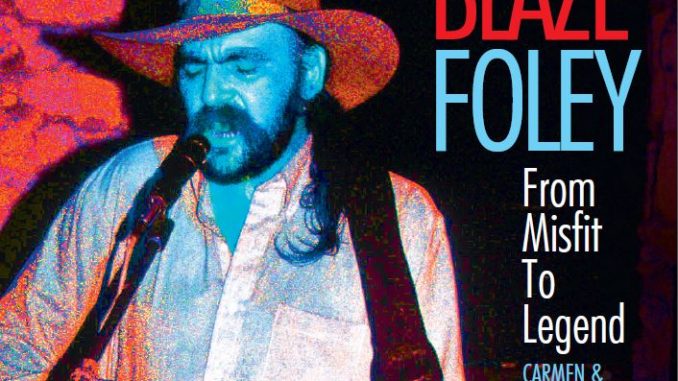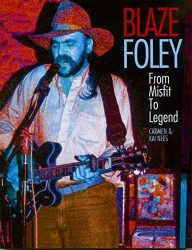
 There can be few things better than books well put together by writers who are passionate about their subject. This book is a wonderful piece of writing/editing born out of a passion for the music of a man who few knew of during his lifetime and who still remains something of a little-known enigma nearly 35 years after his death.
There can be few things better than books well put together by writers who are passionate about their subject. This book is a wonderful piece of writing/editing born out of a passion for the music of a man who few knew of during his lifetime and who still remains something of a little-known enigma nearly 35 years after his death.
Blaze Foley, born Michael David Fuller in Malvern, Arkansas in 1949, was a talented songwriter and performer who struggled with social interaction and had more than a few of his own demons to deal with. He was dead by the age of 39, shot by the son of a man he was trying to help.
This book, from Carmen & Kai Nees, is an excellent presentation of Foley’s life, and death, and a real attempt to uncover the man behind the myth. The book reads almost like a scrapbook, as if someone had assembled a book of cuttings and stray articles and ephemera about someone as they meandered through their life which, in a way, they have. The authors created this book by collecting and commissioning articles from people who knew Foley in his relatively short life, as well as including their own reflections on a man whose talent made a deep connection with them, despite the fact that they never met him or saw him perform live. “This book is a collection of articles originally published elsewhere, texts we commissioned specifically for this book and texts we wrote ourselves – from interviews we conducted with Blaze’s friends, companions, fellow musicians and people who knew him well.” It’s a format that works remarkably well. By the end of the first chapter, ‘The Fall and Rise of Blaze Foley’ you have all the pertinent facts about this artist. You have the basic information about his life, his development as an artist, an indication of the sort of person he was and how he came to meet his untimely death. It’s like the artist’s sketch to outline his painting. From that point, the authors start to paint in detail, bringing in early articles about him, adding photos and personal remembrances, talking to fellow performers and those who knew him in his early days in Georgia, a time when he was known as Depty Dawg, then those that remembered him from his time on the scene in Austin, Texas. We get articles on his recordings, reviews of live appearances, song lyrics, and selections from Kevin Triplett’s production diary on the making of his documentary, ‘Duct Tape Messiah’, a film made about Foley’s life. We get reminiscence from Chuck Lamb, the man who ran the Austin Outhouse, a venue that would become closely associated with Foley. We get a summary of Sybil Rosen’s book, ‘Living in the Woods in a Tree’, about her time with Foley and their short but significant relationship. All the time the authors are adding fine detail, the things that really document a life.
This book is made doubly impressive because of its authors. Husband and wife team, Kai and Carmen Nees, have no background in music journalism and had never written a book before. Having become interested in Foley, largely through seeing him on YouTube clips, they started to collect articles on him. These articles were all in English because they could find no writings about him in their native German. Kai translated these articles into German, and they set about assembling them in a way that portrayed his life and presented the information about him that they would have liked to have had when they first became interested in this fascinating artist. They commissioned additional pieces, conducted interviews with relevant people, and wrote bridging sections themselves to pull everything together. The book was, originally, published in German, back in 2018. The positive response to the book, and the subsequent requests for the book to be available in English, meant that they set about producing an English language version. The first run of that has now sold out and that has meant a second pressing, which is why we’re reviewing the book at this point. The couple did all their own research, cleared the articles and various pictures for inclusion in the book and did the book layout themselves, the only professional input coming from the artist who designed the book cover, Andreas Horn, and a journalist/musician friend, Markus Rill, who acted as their proofreader and helped with some of the translation. Producing this book was a real labour of love for the authors and it shows in every line. It really is a very well put together and very readable book. They even assembled their own website to support the book and facilitate sales to the wider world.
It’s an amazing assembly of facts and stories that really has to be seen as the definitive work on this artist, given the amount of information they have been able to accumulate on someone who had relatively little success in his own lifetime and was dead before he was 40. Blaze Foley didn’t release a single album while he was alive and his brief recording career suffered a series of setbacks that are hard to credit, despite the extensive evidence to support what happened. Since his death, the work of many of the people documented in this book has meant that there are now no less than 8 Foley albums in circulation, along with a number of tribute albums, including the excellent “Blaze Foley’s 113th Wet Dream” from legendary Austin resident, one time Lucinda Williams associate and close friend of Foley’s, Gurf Morlix.
It’s hard enough for biographers to present a comprehensive account of someone who is alive and collaborating with their work, so an endeavour like this really cannot be underestimated. The authors have painted a very detailed picture of an extremely complex artist. Blaze Foley is the man who wrote ‘Clay Pigeons’, covered by John Prine, and the beautiful ‘If I Could Only Fly’, made famous by Willie Nelson and Merle Haggard. He’s the man who was the subject of Lucinda Williams’ song, ‘Drunken Angel’. He’s the man who lived in a tree with an American playwright for two years. He was Depty Dawg and The Duct Tape Messiah. He was a man who was passionate about preventing injustice, to the point that it cost him his life. He was the man of whom Townes Van Zandt, who became a close personal friend, said “He’s only gone crazy once. Decided to stay”.
Carmen and Kai Nees are about to publish their second book on Foley, though it will be in German only, at least for the foreseeable future, and it will be interesting to see what further information they have managed to unearth about this lost talent. I’d heard the name but knew little of Foley’s music before I read this book. Reading this made me go in search of his recordings and it is well worth the effort – Foley is a worthy addition to the list of great Americana songwriters and this is a book that finally acknowledges the depth of his talent.


